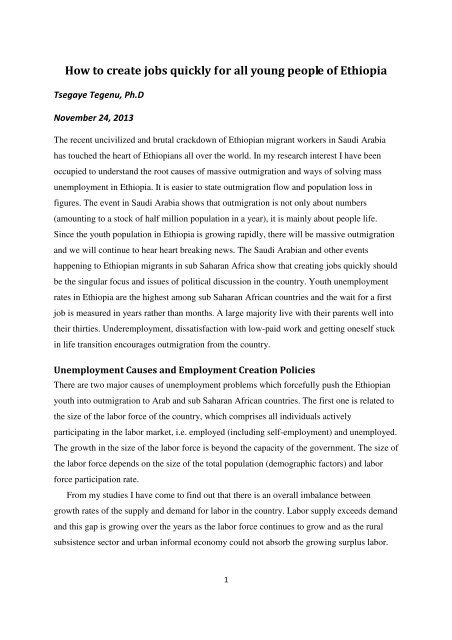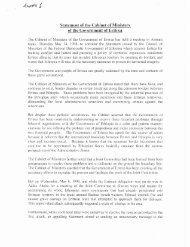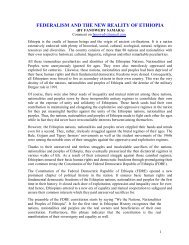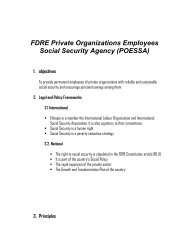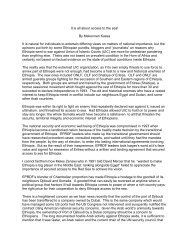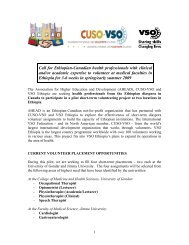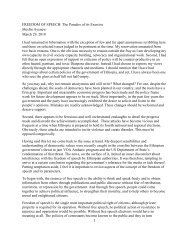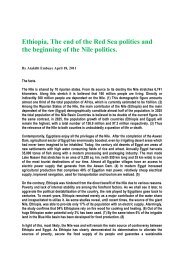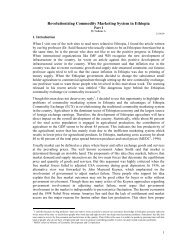How to create jobs quickly for all young people of ... - Aiga Forum
How to create jobs quickly for all young people of ... - Aiga Forum
How to create jobs quickly for all young people of ... - Aiga Forum
Create successful ePaper yourself
Turn your PDF publications into a flip-book with our unique Google optimized e-Paper software.
<strong>How</strong> <strong>to</strong> <strong>create</strong> <strong>jobs</strong> <strong>quickly</strong> <strong>for</strong> <strong>all</strong> <strong>young</strong> <strong>people</strong> <strong>of</strong> EthiopiaTsegaye Tegenu, Ph.DNovember 24, 2013The recent uncivilized and brutal crackdown <strong>of</strong> Ethiopian migrant workers in Saudi Arabiahas <strong>to</strong>uched the heart <strong>of</strong> Ethiopians <strong>all</strong> over the world. In my research interest I have beenoccupied <strong>to</strong> understand the root causes <strong>of</strong> massive outmigration and ways <strong>of</strong> solving massunemployment in Ethiopia. It is easier <strong>to</strong> state outmigration flow and population loss infigures. The event in Saudi Arabia shows that outmigration is not only about numbers(amounting <strong>to</strong> a s<strong>to</strong>ck <strong>of</strong> half million population in a year), it is mainly about <strong>people</strong> life.Since the youth population in Ethiopia is growing rapidly, there will be massive outmigrationand we will continue <strong>to</strong> hear heart breaking news. The Saudi Arabian and other eventshappening <strong>to</strong> Ethiopian migrants in sub Saharan Africa show that creating <strong>jobs</strong> <strong>quickly</strong> shouldbe the singular focus and issues <strong>of</strong> political discussion in the country. Youth unemploymentrates in Ethiopia are the highest among sub Saharan African countries and the wait <strong>for</strong> a firstjob is measured in years rather than months. A large majority live with their parents well in<strong>to</strong>their thirties. Underemployment, dissatisfaction with low-paid work and getting oneself stuckin life transition encourages outmigration from the country.Unemployment Causes and Employment Creation PoliciesThere are two major causes <strong>of</strong> unemployment problems which <strong>for</strong>cefully push the Ethiopianyouth in<strong>to</strong> outmigration <strong>to</strong> Arab and sub Saharan African countries. The first one is related <strong>to</strong>the size <strong>of</strong> the labor <strong>for</strong>ce <strong>of</strong> the country, which comprises <strong>all</strong> individuals activelyparticipating in the labor market, i.e. employed (including self-employment) and unemployed.The growth in the size <strong>of</strong> the labor <strong>for</strong>ce is beyond the capacity <strong>of</strong> the government. The size <strong>of</strong>the labor <strong>for</strong>ce depends on the size <strong>of</strong> the <strong>to</strong>tal population (demographic fac<strong>to</strong>rs) and labor<strong>for</strong>ce participation rate.From my studies I have come <strong>to</strong> find out that there is an over<strong>all</strong> imbalance betweengrowth rates <strong>of</strong> the supply and demand <strong>for</strong> labor in the country. Labor supply exceeds demandand this gap is growing over the years as the labor <strong>for</strong>ce continues <strong>to</strong> grow and as the ruralsubsistence sec<strong>to</strong>r and urban in<strong>for</strong>mal economy could not absorb the growing surplus labor.1
For details on measuring the size and distribution <strong>of</strong> the rural labor <strong>for</strong>ce and employmentdynamics in rural areas see the following discussion papers:http://www.aiga<strong>for</strong>um.com/articles/Labour_Force_Growth.pdfhttp://aiga<strong>for</strong>um.com/articles/GreenRevo_Industrial_policy_Ethiopia.pdfhttp://aiga<strong>for</strong>um.com/articles/Green_Revolution_PartTwo.pdfThe second cause <strong>of</strong> unemployment problem and outmigration is related <strong>to</strong> the limits <strong>of</strong>government job creation policy and strategy. The government has a National EmploymentPolicy and Strategy <strong>to</strong> coordinate the issues <strong>of</strong> employment creation and labor administrationboth in the urban and rural areas and <strong>for</strong>mal and in<strong>for</strong>mal sec<strong>to</strong>rs (see Ministry <strong>of</strong> Labor andSocial Affairs, 2009, National Employment Policy and Strategyhttp://www.ilo.org/dyn/natlex/docs/ELECTRONIC/89584/102962/F1789074138/ETH89584.pdf). On the demand side, the government planned <strong>to</strong> accelerate private sec<strong>to</strong>r development<strong>for</strong> employment generation and ensure effective and efficient public sec<strong>to</strong>r employment. Onthe supply side, the government planned <strong>to</strong> improve and raising labor productivity.If we look at the supply side, the government policy <strong>of</strong> upgrading the education and skilllevels <strong>of</strong> the labor <strong>for</strong>ce could not match the type <strong>of</strong> skill that the economy requires. There is astructural imbalance between the skills, education, experience and aspirations possessed bythe labor <strong>for</strong>ce and the work opportunities provided by the country economy. This problemhas become apparent particularly after the expansion <strong>of</strong> mass rural education andestablishment <strong>of</strong> many higher education institutions <strong>to</strong> improve the supply side <strong>of</strong> theproblem. Parents and students alike perceive “good” <strong>jobs</strong> as requiring a university degree butthe signal and incentive from the labor market is different. The current educational structure<strong>of</strong> the labor <strong>for</strong>ce has <strong>create</strong>d a pattern <strong>of</strong> job aspirations far in excess <strong>of</strong> work opportunitiesavailable. Offering <strong>jobs</strong> <strong>to</strong> graduate students in urban road construction and the consequentdiscussion on cobbles<strong>to</strong>ne project is a good example. The provision <strong>of</strong> higher educationincreased the pressure <strong>to</strong> provide access <strong>to</strong> senior <strong>jobs</strong> within the civil service and large-scalemanufacturing and stimulates general claims <strong>for</strong> increases in salaries and wages. But source<strong>of</strong> employment growth caused by fac<strong>to</strong>rs related <strong>to</strong> shift in final demand is weak due <strong>to</strong> thelow level <strong>of</strong> consumption, investment, government spending and import and export.On the demand side, the government planned <strong>to</strong> accelerate private sec<strong>to</strong>r development <strong>for</strong>employment generation and ensure effective and efficient public sec<strong>to</strong>r employment.Government support <strong>to</strong> private sec<strong>to</strong>r includes credit services, entrepreneurship and business2
management training, appropriate technology research, market support, in<strong>for</strong>mation andcounseling, business development services, and infrastructure provision, including roads,electricity, and water and access <strong>to</strong> land and workplaces. Have these demand side measuresgave birth <strong>to</strong> new businesses and expand existing ones? Where are most <strong>jobs</strong> <strong>create</strong>d: inagriculture, the service and/or manufacturing sec<strong>to</strong>r? <strong>How</strong> fast is employment <strong>create</strong>d in thegiven sec<strong>to</strong>rs?I could not find empirical evidence showing the effects <strong>of</strong> demand side policy on theprocess <strong>of</strong> creation <strong>of</strong> new businesses and expansions <strong>of</strong> existing ones and on thegrowth/decline <strong>of</strong> employment. A study which assessed the demand side <strong>of</strong> the policyconcluded that the national employment policy and strategy is correct and matters <strong>to</strong> <strong>jobs</strong>creation. According <strong>to</strong> this study the problem is not the policy, but constraints related <strong>to</strong>implementation (see Martha Kibru 2012), Employment Ch<strong>all</strong>enges in Ethiopia. Addis AbabaUniversity, retrieve from http://www.festanzania.org/files/fes/pdf/YLTP%20RegConf%20Presentations/Country%20paper%20ethiopia.pdf).I have a different approach <strong>to</strong> the assessment <strong>of</strong> the government policy <strong>of</strong> nationalemployment. Implementation and capacity problems are not specific <strong>to</strong> the employmentpolicy alone; implementation problems affect <strong>all</strong> policy types in the country. My view is tha<strong>to</strong>n the demand side, the government does not have the right strategy and policy in expandingemployment opportunity in the country.In Ethiopia the labor market data collected by CSA is divided in<strong>to</strong> rural and urban. Sincethere is no recent labor market data on rural areas, I will use my earlier study <strong>to</strong> illustrate theemployment dynamic and government ef<strong>for</strong>ts in rural areas. In rural areas the labor <strong>for</strong>ce isgrowing and the work opportunities particularly <strong>for</strong> the <strong>young</strong> age group have <strong>to</strong> increase. Inthe period between 1999 and 2005, the labor <strong>for</strong>ce growth was 1,26 while the employmentgrowth was 1,22. As a result <strong>of</strong> the gap unemployment had increased from 0,31 percent in1999 <strong>to</strong> 3,41 percent in 2005.At the most general level, the sources <strong>of</strong> employment growth in rural areas depend on thegrowth <strong>of</strong> inputs and labor productivity. Land is one <strong>of</strong> the major sources <strong>of</strong> employmentcreation in rural areas. It is the fundamental source <strong>of</strong> agricultural wage employment in therural areas. But there is a problem <strong>of</strong> providing land <strong>for</strong> a growing labor <strong>for</strong>ce.Until now employment creation through land input growth came at the expense <strong>of</strong> theenvironment (cultivation <strong>of</strong> degraded land) and at the expense <strong>of</strong> land fragmentation. Since3
the rural labor <strong>for</strong>ce is growing (counting new entrants, back-log <strong>of</strong> unemploymentaccumulated over the years and work-sharing characteristics <strong>of</strong> the labor <strong>for</strong>ce), the need <strong>for</strong>land is huge. My own estimation is that currently the labor <strong>for</strong>ce needs 21 million hec<strong>to</strong>rs <strong>of</strong>additional land <strong>for</strong> employment creation and food self-sufficiency. Since this is practic<strong>all</strong>yimpossible, the Ethiopian government has adopted a policy <strong>of</strong> promoting improvedtechnological inputs and commercialization <strong>of</strong> the sm<strong>all</strong> scale farm production system. Butthe rural households do not have the capacity <strong>to</strong> adopt the technology.Since area could not expand, land is used intensively through the application <strong>of</strong> morewage labor. Labor intensity in production means a given level <strong>of</strong> output can provide more<strong>jobs</strong>. But labor productivity (output per person employed) has remained on the same level <strong>for</strong>decades despite government agricultural extension programs.To conclude, input growth and productivity are not any longer sources <strong>of</strong> employmentgrowth in rural areas. In rural Ethiopia employment, if any, is distress driven not based ongovernment policy changing final demand. Public and private investment <strong>for</strong> employment isless compared <strong>to</strong> the growth in the labor <strong>for</strong>ce.The urban economy has low ability <strong>to</strong> <strong>create</strong> <strong>jobs</strong>. According <strong>to</strong> 2011 UrbanEmployment/Unemployment Survey <strong>of</strong> CSA the employment <strong>to</strong> population ratio <strong>of</strong> urbanpopulation was 49.4 percent. This means 49.4 percent <strong>of</strong> the <strong>to</strong>tal urban population <strong>of</strong> thecountry aged ten years and above are employed. About 50.6 percent <strong>of</strong> the working agepopulation are not involved in productive activities due <strong>to</strong> unemployment or out <strong>of</strong> the labor<strong>for</strong>ce (inactivity). Economies with high ratios have only 30 percent inactive workingpopulation.Of the urban employed working age population the service sec<strong>to</strong>r absorbed about 70percent <strong>of</strong> the <strong>to</strong>tal employed population. The service sec<strong>to</strong>r include Public Administration,Defense, Compulsory Social Security, Education, Health and other Social activities, Hotel andRestaurant (48.2 percent) and Wholesale and Retail Trades (21.4 percent). Those employedpersons who work in the Manufacturing, Mining, Quarrying and Construction industrialsec<strong>to</strong>rs accounts 20.9 percent.A look at the occupational structure <strong>of</strong> the employment shows that the majority <strong>of</strong>employed persons (43.5 percent) are Service, Shop Market sales; Craft and related Tradeworkers. This was followed by employed persons who are in Elementary Occupations (22.0percent). Pr<strong>of</strong>essionals, Technical and Associate Pr<strong>of</strong>essionals <strong>to</strong>gether constitute 13.0percent. Skilled Agricultural and Fishery workers account 7.7 percent, Clerks 5.6 percent and4
Plant Machine Opera<strong>to</strong>rs and Assemblers 5.2 percent. Legisla<strong>to</strong>rs, Senior Officials andManagers share only 3.0 percent <strong>of</strong> the <strong>to</strong>tal employed population.The employment <strong>to</strong> population ratio, the distribution <strong>of</strong> employment by sec<strong>to</strong>r andoccupation shows that growing labor demand in the service sec<strong>to</strong>r has been the key driver <strong>of</strong>urban employment growth over the past few years. In the urban areas the government nationalemployment policy has favored, if any, the service sec<strong>to</strong>r. The strong aggregate (domestic)demand has been the main fac<strong>to</strong>r behind the expansion in service sec<strong>to</strong>r employment. Theservice sec<strong>to</strong>r is mainly characterized by low-knowledge, low-technology, low-skill, lowwage,and labor-intensive <strong>jobs</strong>.The focus <strong>of</strong> job creation through low knowledge-intensive service activities is not good<strong>for</strong> long term employment and economic growth. According <strong>to</strong> my view the nationalemployment policy should focus on the manufacturing sec<strong>to</strong>r since this sec<strong>to</strong>r plays a leadingrole in innovation and strongly influences other sec<strong>to</strong>rs <strong>of</strong> the economy. Manufacturing is no<strong>to</strong>nly a source <strong>of</strong> innovation, the country needs as well industrial goods. The growth <strong>of</strong>employment in the service sec<strong>to</strong>r shows that manufacturing goods are increasingly made inother countries. The urban economy has now made up <strong>of</strong> roughly 7 times more serviceproviding than goods producing workers. The service sec<strong>to</strong>r, even if it has currently a lot <strong>of</strong><strong>jobs</strong>, it does not generate more income per worker like manufacturing industries. Sec<strong>to</strong>rs likemanufacturing that generate more income per worker have much bigger ripple effects,creating much more impact in the country while helping <strong>to</strong> raise wages in lower-productivityservice sec<strong>to</strong>rs.Policy Framework <strong>for</strong> Employment CreationI see both policy design limitations and wrong choices <strong>of</strong> strategies. In the following threesections I will describe framework and principles which guide the <strong>for</strong>mulation <strong>of</strong>industrialization and national employment policy: what not <strong>to</strong> do, what <strong>to</strong> do, and how <strong>to</strong> doit.What not <strong>to</strong> do: Ideology and Party based Policy Choices<strong>How</strong> <strong>to</strong> <strong>create</strong> more <strong>jobs</strong> <strong>for</strong> the urban and rural surplus labor at a speed <strong>of</strong> the labor mobilityshould be based on evidences and evaluation <strong>of</strong> how well the policy has so far worked."Evidence-based policy is a rigorous approach that draws on careful data collection,experimentation, and both quantitative and qualitative analysis <strong>to</strong> answer three questions:5
What exactly is the problem? What are the possible ways <strong>to</strong> address the problem? And whatare the probable impacts and costs <strong>of</strong> each?"Development and job creation policies in Ethiopia have been conceived, debated, andevaluated through the lenses <strong>of</strong> party ideology, politics and belief. In the current politics thereis a fundamental belief that sm<strong>all</strong> farms can contribute <strong>to</strong> the creation <strong>of</strong> employment andimproving <strong>of</strong> food security. According <strong>to</strong> my view the hope <strong>to</strong> <strong>create</strong> more <strong>jobs</strong> in rural areasthrough the provision <strong>of</strong> support <strong>to</strong> sm<strong>all</strong>holder farmers is a wishful thinking. (<strong>for</strong> details seehttp://aiga<strong>for</strong>um.com/articles/miss_conceptualizing_sm<strong>all</strong>farms.pdf;)In rural Ethiopia land based agricultural activities have not contributed <strong>to</strong> the creation <strong>of</strong>productive employment, if they do it is through land fragmentation or hunger plots. In ruralareas the domestic input material (land and labor) is used <strong>for</strong> rural household multiplication,not <strong>for</strong> new activities, outputs and production increase. In the rural Ethiopia, labor <strong>for</strong>ce is no<strong>to</strong>nly large but also rapidly increasing. In a situation where there is a limited final demand andwhere there is less output augmenting fac<strong>to</strong>rs (capital, fertilizers, water), increase in laborsupply leads <strong>to</strong> low productivity <strong>of</strong> the employment sec<strong>to</strong>r, and because <strong>of</strong> the low inputnature <strong>of</strong> the sec<strong>to</strong>r. Employment is <strong>create</strong>d by low inputs and this lead <strong>to</strong> unproductiveemployment. The government interventions so far do not increase agricultural productivityand generate rapid employment.On both urban and rural areas the government focused on the wrong sec<strong>to</strong>rs <strong>of</strong> theeconomy (agriculture and service sec<strong>to</strong>rs) as sources <strong>of</strong> economic and employment growth.Presumably, the government focused on these sec<strong>to</strong>rs <strong>for</strong> ideological reasons, moral orpolitical interests. My view is that <strong>for</strong> more job creation, it is fundamental that the governmenthas <strong>to</strong> chose industry over agriculture in unequivocal manner. The Agricultural DevelopmentLed Industrialization is not working <strong>for</strong> various reasons. To begin with there is no his<strong>to</strong>ricalcase showing agriculture leading <strong>to</strong> industrialization even if there seem <strong>to</strong> be a logic <strong>to</strong> ide<strong>all</strong>ylink agriculture <strong>to</strong> industry (see Figure 1 used <strong>of</strong>ten by government pr<strong>of</strong>essionals).Figure 1: Agricultural Development Led Industrialization Logic6
According <strong>to</strong> my view the sources <strong>of</strong> industrialization are capital accumulation (bothphysical and human), technological development and trade. In case <strong>of</strong> Europe and Japan,industrialization grew out <strong>of</strong> pro<strong>to</strong> industrialization (goods mainly manufactured in urbanworkshops and homes), not from agriculture. In case <strong>of</strong> East Asian countries, industrializationgrew out <strong>of</strong> non resource based activities related <strong>to</strong> human capital development (ICT in Indiaand electronics in case <strong>of</strong> Korea, China and Taiwan). In case <strong>of</strong> England, rapidindustrialization was partly related <strong>to</strong> trade and demand. The simple association thatagriculture is linked <strong>to</strong> non-farm rural activities does not mean that it leads <strong>to</strong>industrialization. Non-farm rural activities, including the traditional manufacturing activitiesare different from fac<strong>to</strong>ry organized activities in terms <strong>of</strong> scale, diversity, technology,specialization and complexity.The idea <strong>to</strong> dramatic<strong>all</strong>y expand rural material inputs (labor and land resources) and usethem as major industrial sources is a wishful thinking. To wait <strong>for</strong> sm<strong>all</strong> holder farmers (about12 millions) <strong>to</strong> be prosperous and serve as basis <strong>for</strong> industrialization is having a wrongassumption about their nature. As I have discussed in previous postings, sm<strong>all</strong>holder farmersare demographic units <strong>of</strong> reproduction. The fact that they are crop producers does not meanthat they are entrepreneurs. They are basic<strong>all</strong>y consumption units (mainly child richhouseholds) left with no surplus <strong>for</strong> the market. Firm theory does not apply <strong>to</strong> them and I seeno reason why one expects industrialization out <strong>of</strong> their multiplication.What I am trying <strong>to</strong> say is that agriculture and service sec<strong>to</strong>rs are not and will not lead <strong>to</strong>industrialization and job creation. It is better <strong>for</strong> the government <strong>to</strong> think <strong>of</strong> other instrumentsand mechanisms <strong>of</strong> industrialization. This does not mean agriculture should be left inabeyance. Agriculture needs structural change in the <strong>for</strong>m <strong>of</strong> selective green revolution7
interventions <strong>for</strong> the purpose <strong>of</strong> food security and rural industrialization. I will come back <strong>to</strong>the issue <strong>of</strong> rural industrialization at the end <strong>of</strong> discussing the alternative policy instruments.My conclusion is that it is mainly by focusing on industrialization that more productive<strong>jobs</strong> will be <strong>create</strong>d in the country. The focus on industrialization makes us <strong>to</strong> thinkdifferently and worry about finding non agricultural/service means and instruments <strong>of</strong> rapidindustrialization. To lower the plight <strong>of</strong> the youth in Ethiopia, the government has <strong>to</strong> changeits line <strong>of</strong> development thinking, choice <strong>of</strong> strategies and means <strong>of</strong> creation <strong>of</strong> <strong>jobs</strong> in thecountry (from mindset <strong>of</strong> Figure 1 <strong>to</strong> the approaches <strong>of</strong> Figure 2).What <strong>to</strong> Do: Six Policy InstrumentsAt the level <strong>of</strong> mechanisms, job creation requires a government capacity <strong>to</strong> properly identifypolicy instruments. There are six policy instruments which can be used <strong>for</strong> rapidindustrialization and employment creation in the country. In the following I will brieflydiscuss the six instruments, and if required I will come back with details in the near future.Policy Instrument 1: Construction <strong>of</strong> Special Economic ZonesSpecial Economic Zones (SEZs) are defined as geographic<strong>all</strong>y delimited areas “with asingle management or administration and a separate cus<strong>to</strong>ms area (<strong>of</strong>ten duty free), where8
streamlined business procedures are applied and where firms physic<strong>all</strong>y located within thezone are eligible <strong>for</strong> certain benefits”. Special economic zones serve as “demonstration areas”<strong>for</strong> policy re<strong>for</strong>ms and <strong>to</strong> encourage <strong>for</strong>eign investment. There are over 3500 zones in theworld and the development <strong>of</strong> these zones has helped <strong>to</strong> improve global trade relations andhas <strong>create</strong>d over 70 million <strong>jobs</strong> and hundreds <strong>of</strong> billions <strong>of</strong> dollars in trade revenue.Industrial development zone (IDZ) is mention in the industrial section <strong>of</strong> the GTP. In arecent workshop on industrial development in Ethiopia, I learned that this part <strong>of</strong> the policywas drafted by a few key persons without systematic prior consultation with businesses andrelevant ministries. On 30 August 2013, a Strategic Partnership and Consultancy ServiceAgreement on the development <strong>of</strong> Special Economic Zones and Industrial Parks in Ethiopiawas signed between China and Ethiopia.Policy Instrument 2: Industrial Cluster InitiativesCluster refers <strong>to</strong> a group companies and other institutions in related industries that are colocatedin a specific geographic region. Clustering can enhance the individual capacities <strong>of</strong>sm<strong>all</strong> firms <strong>to</strong> access markets, and acquire skills, knowledge, credit and in<strong>for</strong>mation. For acompany <strong>to</strong> operate out <strong>of</strong> cluster is disadvantageous. But these advantages are not given.Particularly in developing countries these advantages do not work because <strong>of</strong> weakinstitutions, labor oversupply, and sm<strong>all</strong> size <strong>of</strong> the market. There is a need <strong>for</strong> clusterinitiation, planning, managing and funding <strong>to</strong> overcome institutional weaknesses. Anyorganized ef<strong>for</strong>t <strong>to</strong> enhance the competitiveness <strong>of</strong> a cluster is also c<strong>all</strong>ed a cluster initiative.The stronger the cluster, the higher the survival rate <strong>of</strong> new businesses, the more dynamic isthe process <strong>of</strong> new business <strong>for</strong>mation, the more likely new industries within the cluster are <strong>to</strong>emerge, and the higher the job growth in new businesses. Because <strong>of</strong> these economicadvantages European countries have started <strong>to</strong> construct industrial cluster organization sincethe early 1990s. More than 1400 cluster initiatives are identified glob<strong>all</strong>y.In the case <strong>of</strong> Ethiopia, there are two major types <strong>of</strong> clusters. The first types are naturalcluster that spontaneously grow out <strong>of</strong> the concentration <strong>of</strong> economic activities based onmarket <strong>for</strong>ces over a long period <strong>of</strong> time. Examples <strong>of</strong> such clusters are the footwear cluster inMerca<strong>to</strong> area and the handloom cluster in Shiromeda area <strong>of</strong> Addis Ababa. The second typesare government planned clusters that are <strong>create</strong>d through a deliberate policy <strong>of</strong> constructing aworking premises. Planned clusters have associations but they are very few in number andtheir establishment dates back <strong>to</strong> 2004. In Ethiopia the great majority <strong>of</strong> the clusters are9
natural and spontaneous and they have no organizations <strong>to</strong> develop their industrialcompetitive capabilities.Policy Instrument 3: Regional Industrialization Master Plans and RuralIndustrialization ProgramsIn 2010, the Amhara region has conducted a comprehensive study <strong>to</strong> develop a 10 year masterplan aimed at developing industrialization in the region. Even if I have no in<strong>for</strong>mation as <strong>to</strong>the implementation <strong>of</strong> the plan, I find the study relevant and necessary <strong>to</strong> startindustrialization. The plan has an over<strong>all</strong> objective <strong>of</strong> developing the existing potentials <strong>of</strong> themedium and large firms in the region and creation <strong>of</strong> more productive <strong>jobs</strong> <strong>for</strong> the surpluslabor <strong>of</strong> the region. To develop rural industrialization program, the plan needs further studyon quantify resource needs <strong>of</strong> the existing firms, value chain/resource costs analysis and astudy on the per<strong>for</strong>mance <strong>of</strong> sm<strong>all</strong>-scale industries in the region. Value chain analysis <strong>of</strong>certain industrial products (i.e., study <strong>of</strong> fac<strong>to</strong>rs that affect costs <strong>of</strong> a selected commodity) wasnot part <strong>of</strong> the study. Assessing the per<strong>for</strong>mance <strong>of</strong> sm<strong>all</strong>-scale industries had received lessattention in the study. I believe that the plan scope will expand <strong>to</strong> accommodate theselimitations as the plan implementation and learning proceeds. The 10 year master plan <strong>for</strong> thedevelopment <strong>of</strong> the industrial Sec<strong>to</strong>r in Amhara Region is worth emulating <strong>for</strong> the creation <strong>of</strong>manufacturing <strong>jobs</strong> in rural parts <strong>of</strong> Ethiopia.Policy Instrument 4: Green revolution, agro-industrialization and value addedprocessing <strong>of</strong> primary productsFor details see:http://aiga<strong>for</strong>um.com/articles/GreenRevo_Industrial_policy_Ethiopia.pdfhttp://aiga<strong>for</strong>um.com/articles/Green_Revolution_PartTwo.pdfhttp://aiga<strong>for</strong>um.com/articles/Green_Revolution_response1.htmhttp://aiga<strong>for</strong>um.com/articles/Green_Revolution_sm<strong>all</strong>holder.htmhttp://aiga<strong>for</strong>um.com/articles/Final_response_on_green_revolution.htmPolicy Instrument 5: Horizontal Industrial PolicyThis policy instrument promotes human resources through education, training, research andskill development. The aim <strong>of</strong> horizontal industrial policy is <strong>to</strong> secure framework conditionsfavorable <strong>to</strong> industrial competitiveness. Its instruments, which are those <strong>of</strong> enterprise policy,aim <strong>to</strong> provide the framework conditions in which entrepreneurs and business can takeinitiatives, exploit their ideas and build on their opportunities.10
Policy Instrument 6: Sec<strong>to</strong>ral-specific industrial policyPolicy instrument targeting a sec<strong>to</strong>r not necessarily aimed at the whole <strong>of</strong> manufacturing oreven limited <strong>to</strong> the manufacturing sec<strong>to</strong>r in its scope. The government takes a concerted,focused and conscious ef<strong>for</strong>t <strong>to</strong> encourage and promote a specific sec<strong>to</strong>rs with an array <strong>of</strong>policy <strong>to</strong>ols.The Ethiopian government identified the following priority sec<strong>to</strong>rs <strong>for</strong> direct support:textile and garment; meat, leather and leather products; agro-processing industries,construction and micro and sm<strong>all</strong> enterprises (MSEs). For details on sec<strong>to</strong>ral strategies seeAdmit Zerihun, "Industralization Policy and Industrial Development Strategy <strong>of</strong> Ethiopia" inTaye Assefa, ed. (2008), Digest <strong>of</strong> Ethiopia' National Policies, Strategies and Programs. PartI: Social Sec<strong>to</strong>r. Addis Ababa, FSS.<strong>How</strong> <strong>to</strong> Do It: Suggestion on policy making procedure and organizationAt level <strong>of</strong> implementation, industrialization and job creation requires a tradition <strong>of</strong> policyprocedure and organization from which good policies are produced and executed. In Ethiopia,the organizational structure <strong>of</strong> industrialization seems <strong>to</strong> be centralized under the PrimeMinister <strong>of</strong>fice, a lead ministry and a technocrat team supporting the ministers. While sucharrangements are speedy and good <strong>for</strong> short cuts, they are not suitable <strong>for</strong> dialog with thepublic and private stakeholders. To avoid "know-it-<strong>all</strong> attitude" the steps in Figure 3 aresuggested <strong>for</strong> drafting the six policy instruments.11
Figure 3: Policy Making Procedure and Organizations, modified and adopted from KenichiOhno (2011), Policy Procedure and Organization <strong>for</strong> Executing High Priority IndustrialStrategies. GRIPS, Tokyo.Industrialization and job creation is not only the promotion <strong>of</strong> selective driving fac<strong>to</strong>rs andtechnology based economic activities, it is also a conscious ef<strong>for</strong>t <strong>of</strong> institutionaltrans<strong>for</strong>mation <strong>to</strong> increase diversity and production scale, the number <strong>of</strong> firms, their linkagesand employment creations. Based on demographic based projection, I tried in previouspostings <strong>to</strong> warn about population loss and economic crash and advised <strong>for</strong> alternative policymeasures and mindset changes. But there is no one <strong>to</strong> listen.I would like <strong>to</strong> dedicate this piece <strong>of</strong> article <strong>to</strong> fellow Ethiopian migrant workers in Araband sub Saharan African countries.For comments: tsegaye.tegenu@epmc.se12


